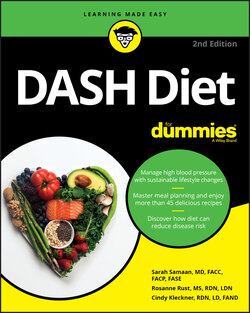Читать книгу DASH Diet For Dummies - Sarah Samaan - Страница 62
Decreasing the amount of saturated fat, cholesterol, and sodium
ОглавлениеIn general, you should choose less packaged, processed food. The DASH diet is low in saturated fat, so keep an eye out for the amounts you see on food labels. Look for foods that have less than 1.5 grams of saturated fat per serving. DASH is also low in cholesterol and total fat and limits sugary foods and beverages.
The DASH diet is lower in sodium, recommending no more than 2,300 milligrams per day. The 2010 dietary guidelines for Americans advise people who already have high blood pressure, or have diabetes or kidney disease, to consume no more than 1,500 milligrams of sodium per day. This guideline also applies to middle-aged or older adults. Younger, healthy folks can handle a bit more sodium, but staying under 2,300 milligrams per day is a good bet. However, even with sodium levels at around 3,000 milligrams a day, when all other DASH guidelines were employed, blood pressure was still reduced. Still, the DASH research shows that eating plans that are lower in sodium lower blood pressure even more. Table 4-2 shows the breakdown of various nutrients used in the DASH studies.
Of course, because one of the goals of the DASH diet is also to maintain a healthy body weight, you must figure out how many calories you need. To lose weight, you must create a calorie deficit. See the sidebar “How many calories do you need?” for help calculating the amount of calories needed to maintain your weight.
TABLE 4-2 Daily Nutrient Goals Used in DASH Diet Studies
| Macronutrient | Percentage of Daily Calories |
|---|---|
| Total fat | 27% |
| Saturated fat | 6% |
| Protein | 18% |
| Carbohydrate | 55% |
| Nutrient | Amount |
| Cholesterol | 150 milligrams (mg) |
| Sodium | 2,300 mg |
| Potassium | 4,700 mg |
| Calcium | 1,250 mg |
| Magnesium | 500 mg |
| Fiber | 30 grams |
Source: National Heart, Lung, Blood Institute
